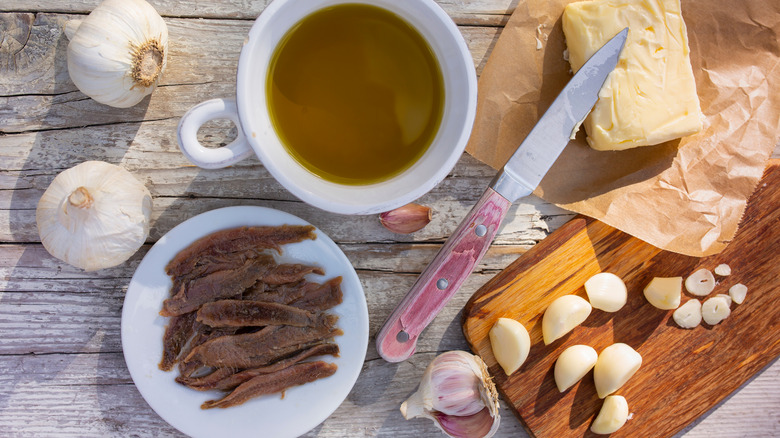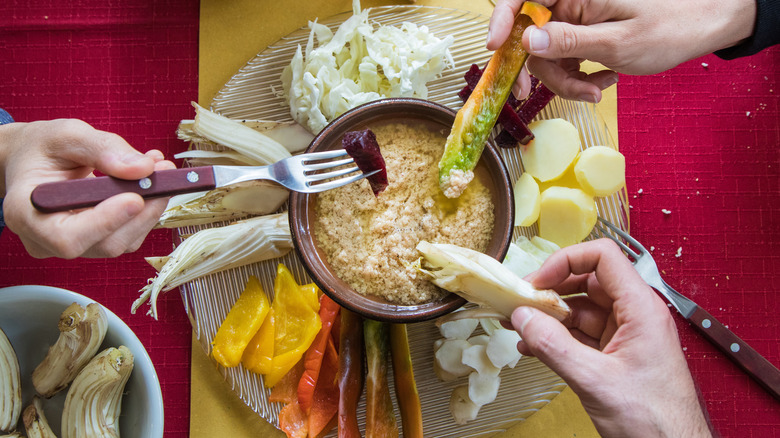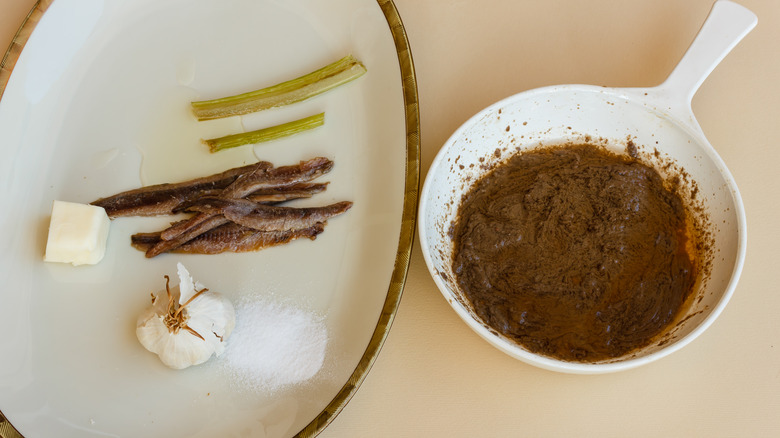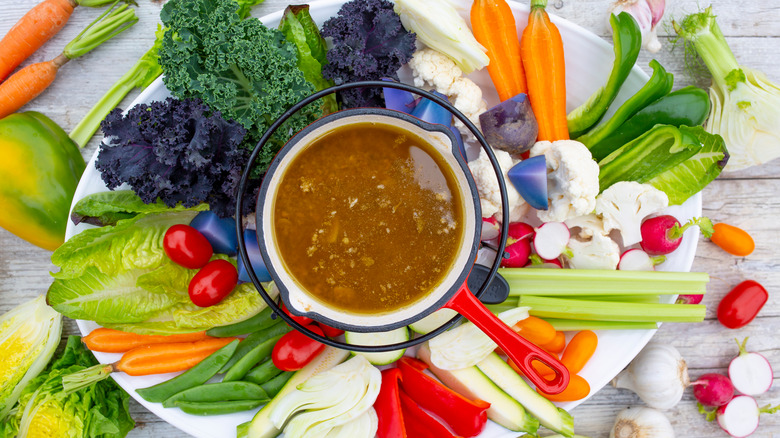What Is Bagna Càuda And What's It Taste Like?
In Piedmont, Italy, the completion of the fall grape harvest is cause for great celebration, and what better way to commemorate the vital step in wine-making than with food? This jubilant time in Piedmont — which is located in northwest Italy — is known as vendemmia. To toast to their harvest, one staple on the tables of grape growers and pickers was always bagna càuda, according to Enjoy Food & Wine.
So what is bagna càuda? Life in Italy explains that bagna càuda means "hot sauce" in Piedmontese. But it's not like the spicy hot sauce that may first come to mind — it's literally served warm in the style of fondue. In traditional Piedmont fashion, bagna càuda is actually served as a savory dip. The dish is now one of the most revered dishes from the region, per Fork n Plate, and often graces the table at other celebratory occasions such as Christmas. As far as appetizers go, bagna càuda certainly packs a punch.
What does bagna càuda taste like?
Traditional bagna càuda is a pungent mix of garlic, anchovies, and olive oil, cooked together to make a warm sauce. With aromatic and powerful primary ingredients like anchovy and garlic, bagna cauda's flavor is anything but mild. Food52 says that according to the original recipe, based on serving size, bagna càuda calls for one head of garlic per person, so the sauce is certainly heavy on the potent bulb.
As for the anchovies, they are the star of the dish. Unlike sauces that rely on anchovies to blend into the background of a sauce, such as a tomato sauce, bagna càuda keeps them front and center. The result is a punch of salty, fishy flavor at the forefront of the sauce. Sometimes butter or milk are added to the sauce, but olive oil is essential. The result is a thick, mash-like dip. As far as what to dip in bagna càuda, a medley of vegetables are traditionally served with the dish — chosen to play off of the salty, savory, garlicky nature of the sauce.
Why are anchovies a major ingredient in bagna càuda?
Bagna càuda has a history as rich as its flavor profile. The origin of the dish lies in Piedmont, a northwest region of Italy located in the Alpine foothills, according to Fork n Plate. The region is landlocked, so there is speculation about how a sauce with a main ingredient of anchovies — which had to be imported into the area — became so prevalent on the tables of everyday folks in Piedmont. The story of how anchovies got to the area, per Fork n Plate, goes like this: Salt was a treasured commodity since the Roman times, and traders from the coastal region of Liguria — which was connected to Piedmont by what was known as a "salt road" — wanted to find a way to trade their salt for Piedmont's products like grains and butter. Though, they wanted to trade without having to pay any of the high taxes that salt required.
Anchovies, unlike salt, were not taxed. Fork n Plate explains that the tricky traders took to lining barrels full of salt with a layer of anchovies on top, so if anyone checked, the vessels would appear to be full of anchovies. So Piedmont residents got their salt with a layer of salt-cured anchovies they had to put to use — enter bagna càuda.
How to serve bagna càuda
When it comes to how to eat bagna càuda, the variety of vegetables you serve with the dip matters. Vegetables like the cardoon (a stalky thistle with close relation to the artichoke), radicchio, endive, raw bell peppers, and grilled onion, are all go-to choices, per the James Beard Foundation. Regardless of the exact veggies you choose, make sure to pick those with an array of textures, flavors, and colors. Food52 adds that boiled potatoes are also a common dipper for the sauce.
Radicchio and endive are great picks because they complement the pungent, oily flavors of the dish with their bitterness. Bell peppers, on the other hand, add to the mix with their sweetness. According to Fork n Plate, bagna càuda originated partially to make winter vegetables more tempting and is often served as a midday warming snack for vineyard workers on cold days. And if eating the sauce as a dip sounds like too much of a mouthful, though untraditional, bagna càuda can be served with steak.
Because bagna càuda is a hot sauce, it's often served over a flame to keep the dish warm as it's eaten — either in a fondue-style dish or in individual bowls.



